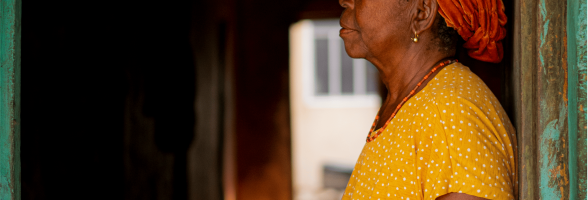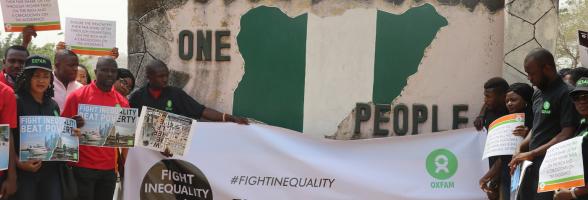- Oxfam predicts there will be at least five trillionaires a decade from now.
- 204 new billionaires were minted in 2024, nearly four every week.
- Sixty percent of billionaire wealth is now derived from inheritance, monopoly power or crony connections, as Oxfam argues that “extreme billionaire wealth is largely unmerited.”
- Richest 1 percent in the Global North extracted $30 million an hour from the Global South through the financial system in 2023.
- Oxfam urges governments to tax the richest to reduce inequality, end extreme wealth, and dismantle the new aristocracy. Former colonial powers must address past harms with reparations.
Nigeria's wealth gap has reached crisis levels, with the richest individuals accumulating unprecedented wealth while the poor struggle to survive. In 2024, billionaire wealth surged, and this trend is expected to continue, with at least five trillionaires emerging in the next decade, according to our findings.
A staggering 60% of billionaire wealth in Nigeria is derived from inheritance, monopoly power, or crony connections, perpetuating a system of economic inequality. This unmerited wealth concentration is exacerbated by a regressive tax system and high cost of governance, which disproportionately benefits the wealthy elite.
In Nigeria, the wealth of four billionaires (US $23.7 billion) could easily cover the whole of Lagos city in 500 naira notes. Meanwhile, over 133 million people, about 70% of the population, face hunger, with women and girls disproportionately affected, making up nearly 63% of the hungry population.
Oxfam publishes “Takers Not Makers” today as business elites gather in the Swiss resort town of Davos and billionaire Donald Trump, backed by the world’s richest man Elon Musk, is inaugurated as President of the United States.
The report also shines a light on how, contrary to popular perception, billionaire wealth is largely unearned —60 percent of billionaire wealth now comes from inheritance, monopoly power or crony connections. Unmerited wealth and colonialism —understood as not only a history of brutal wealth extraction but also a powerful force behind today’s extreme levels of inequality— stand as two major drivers of billionaire wealth accumulation.
Many of the super-rich, particularly in Europe, owe part of their wealth to historical colonialism and the exploitation of poorer countries. For example, the fortune of billionaire Vincent Bolloré, who has put his sprawling media ‘empire’ at the service of France's nationalist right, was built partly from colonial activities in Africa.
“The chasm of wealth inequality between rich countries and Majority World countries is not an accident — it’s the legacy of colonialism. Former colonial powers didn’t just exploit resources on an unimaginable scale; they also designed and built a global financial architecture to perpetuate that theft...”
Low and middle-income countries spend on average nearly half of their national budgets on debt repayments, often to rich creditors in New York and London. Nigeria’s debt to service ratio rose to 162% in 2024, as compared to 128% in 2023.
The legacy of colonialism plays a significant role in Nigeria's economic disparities, with the country's wealth largely controlled by a small elite. The richest 1% hold a disproportionate amount of power and influence, leaving the majority of Nigerians behind.
“Nigeria's wealth gap is a moral and social crisis. While a few individuals amass immense wealth, over 133 million Nigerians face hunger daily. This extreme inequality is largely unearned, built on inheritance, monopolies, and unfair advantages. We must act now to create a fairer system—by taxing the richest, addressing injustices, and investing in services that lift millions out of poverty.”
Oxfam is calling on governments to act rapidly to reduce inequality and end extreme wealth:
- Radically reduce inequality. Governments need to commit to ensuring that, both globally and at a national level, the incomes of the top 10 percent are no higher than the bottom 40 percent. According to World Bank data, reducing inequality could end poverty three times faster. Governments must also tackle and end the racism, sexism and division that underpin ongoing economic exploitation.
- Tax the richest to end extreme wealth. Global tax policy should fall under a new UN tax convention, ensuring the richest people and corporations pay their fair share. Tax havens must be abolished. Oxfam’s analysis shows that half of the world’s billionaires live in countries with no inheritance tax for direct descendants. Inheritance needs to be taxed to dismantle the new aristocracy. In Nigeria, report by the Federal Inland Revenue Service has it that only 40 wealthy individuals pay taxes, the other question is whether the taxes they pay are fair to the income/profit they make. The ongoing tax and fiscal reforms must put a search light on taxing the rich, not just the billionaires but the millionaires in hundreds.
- End the flow of wealth from the global South to the global North. Cancel debts and end the dominance of rich countries and corporations over financial markets and trade rules. This means breaking up monopolies, democratizing patent rules, and regulating corporations to ensure they pay living wages and cap CEO pay as well as stop eschewing trade relations in the favour of good/commodities that the global north markets needs rather than those that will benefit markets in the global south. Restructure voting powers in the World Bank, IMF and UN Security Council to guarantee fair representation of Global South countries. Former colonial powers must also confront the lasting harm caused by their colonial rule, offer formal apologies, and provide reparations to affected communities.
The Nigerian government should:
- Raise social sector spending to at least 10% of the national budget
- Prioritize investments in health, education, and agriculture to bridge the wealth gap and improve human development outcomes.
- Develop a comprehensive wealth registry and stronger tax enforcement will ensure high-net-worth individuals contribute fairly.
Maxwell Osarenkhoe | Communication Officer | maxwell.osarenkhoe@oxfam.org | +234 807 594 9898
For more information about Oxfam and its work in Nigeria, follow us on X(Twitter), Facebook, Instagram and LinkedIn
Download Oxfam’s global report “Takers not Makers” and the methodology note.
Download Oxfam in Nigeria’s Income and Wealth Inequality Report 2024
According to the World Bank, the actual number of people living on less than $6.85 a day has barely changed since 1990.
Oxfam calculates that 60 percent of billionaire wealth is either from crony or monopolistic sources or inherited. Specifically, 36 percent is inherited, 18 percent comes from monopoly power, and 6 percent is from crony connections.
On average, low and middle-income countries are spending 48 percent of their national budgets on debt repayments.
Vincent Bolloré bought several former colonial companies in Africa, taking advantage of the wave of privatizations spurred by the structural adjustment programs imposed by the IMF and the World Bank in the 1990s. This strategy enabled Bolloré to build an extensive transport-logistics network in Africa, operating in 42 ports across the continent.
According to the ILO, women in the informal economy are more often found in the most vulnerable situations, for instance as domestic workers, home-based workers or contributing family workers, than their male counterparts.
ILO data also shows that migrant workers in high-income countries earn about 12.6 percent less than nationals, on average. The pay gap between men nationals and migrant women in high-income countries is estimated at 20.9 percent, which is much wider than the aggregate gender pay gap in high-income countries (16.2 percent).


